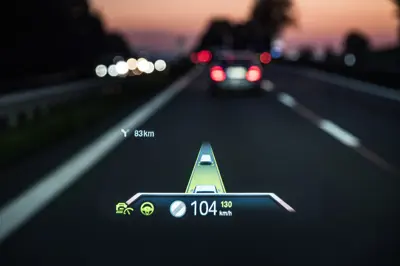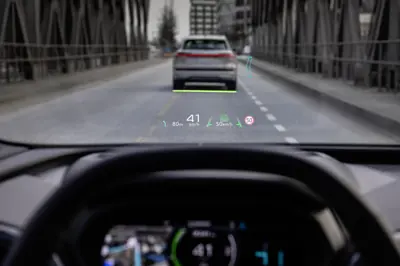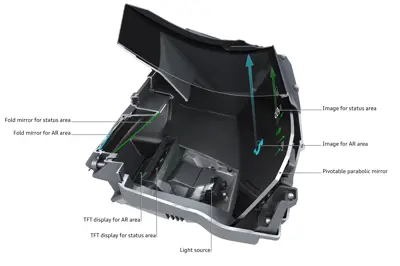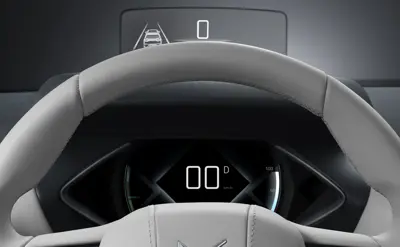- User Interface
- Screens
- Head-up Display
- Physical Buttons
- Steering wheel
- Stalks
- Mirrors
- Voice Control
- Gesture Control
Head-up Display
Head-up displays (HUDs) in cars are advanced technology that projects information onto the windshield or a transparent screen, allowing the driver to view essential data without taking their eyes off the road.
Head-up displays (HUDs) are designed to provide a safer and more convenient way for drivers to access essential information while driving, helping them keep their eyes on the road and minimize distractions.
HUDs typically display information such as speed, navigation directions, incoming calls, and other vehicle data directly onto the windshield or a transparent screen within the driver's field of vision.
The HUD allows the driver to view critical information without looking down at the dashboard or infotainment screen, reducing the need to take their eyes off the road.
Augmented Reality HUD
Augmented reality (AR) in the context of head-up displays (HUDs) in cars refers to a technology that overlays virtual or digital content onto the real world.
AR HUDs in cars can display the same information as standard HUDs. However, AR HUDs use advanced technologies like sensors, cameras, and computer algorithms to capture and process real-time data from the vehicle’s surroundings, such as the road, traffic, and objects.
The AR HUD uses this data to generate superimposed virtual content onto the HUD display. By combining real-world data with virtual information, AR HUDs can provide drivers with enhanced situational awareness and improved safety. They can receive important information without taking their eyes off the road.
How Does It Work?
HUDs use different methods to project information onto the windshield or transparent screen. One common approach is to use a system of mirrors or lenses to reflect the data onto the windshield, creating a virtual image that appears to float in front of the driver.
Another method is to use a transparent screen, such as a thin plastic or glass panel, positioned in the driver’s line of sight to display the information directly.
Car manufacturers design HUDs to be visible in various lighting conditions, including daytime and nighttime driving. They typically have adjustable brightness and contrast settings, and some models may also have automatic brightness adjustments to adapt to changing ambient light conditions.
Limitations of HUDs
While HUDs offer many benefits, there are some limitations to consider. For example, HUDs may not be suitable for all drivers or vehicles, as they may obstruct the driver’s view or distract some individuals.
Polaroid sunglasses can also prevent the driver from seeing the screen.
In the EVKX EV database, you can search for models with HUD.




